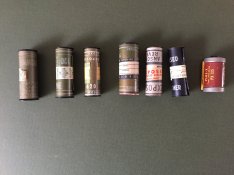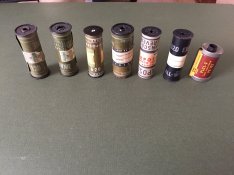Bioflex
Member

 I bought these seven rolls of exposed film recently at a flea market along with some photo equipment.I was surprised to see four of the rolls are Kodak SuperXX with Army olive green paper backing.One roll is Ansco All Weather, one roll Ansco Color Reversible , one roll Kodak Plus-x 35mm.I was informed that they were taken in Korea during the war.I didn’t realize Kodak made film just for military use. I am presently researching best process for the b&w film I am thinking about Kodak HC-110 dilution B for around 18 mins. For the SuperXX. Not sure how curled it will be, might have develop by “see-saw” method as opposed to Patterson or SS reels.Any suggestions for a lab for the Ansco color reversible? I’m thinking it is a slide film? Thank you
I bought these seven rolls of exposed film recently at a flea market along with some photo equipment.I was surprised to see four of the rolls are Kodak SuperXX with Army olive green paper backing.One roll is Ansco All Weather, one roll Ansco Color Reversible , one roll Kodak Plus-x 35mm.I was informed that they were taken in Korea during the war.I didn’t realize Kodak made film just for military use. I am presently researching best process for the b&w film I am thinking about Kodak HC-110 dilution B for around 18 mins. For the SuperXX. Not sure how curled it will be, might have develop by “see-saw” method as opposed to Patterson or SS reels.Any suggestions for a lab for the Ansco color reversible? I’m thinking it is a slide film? Thank you




